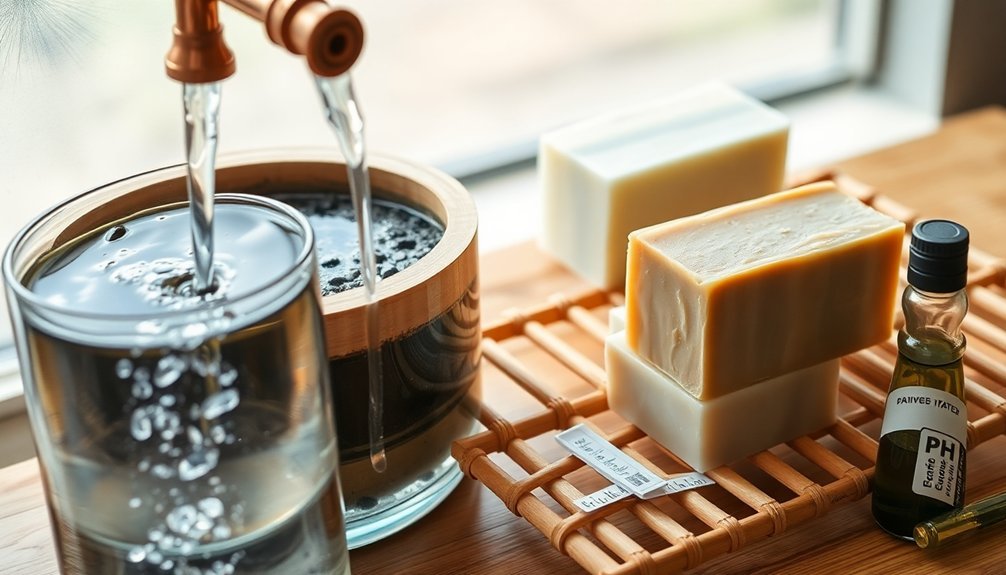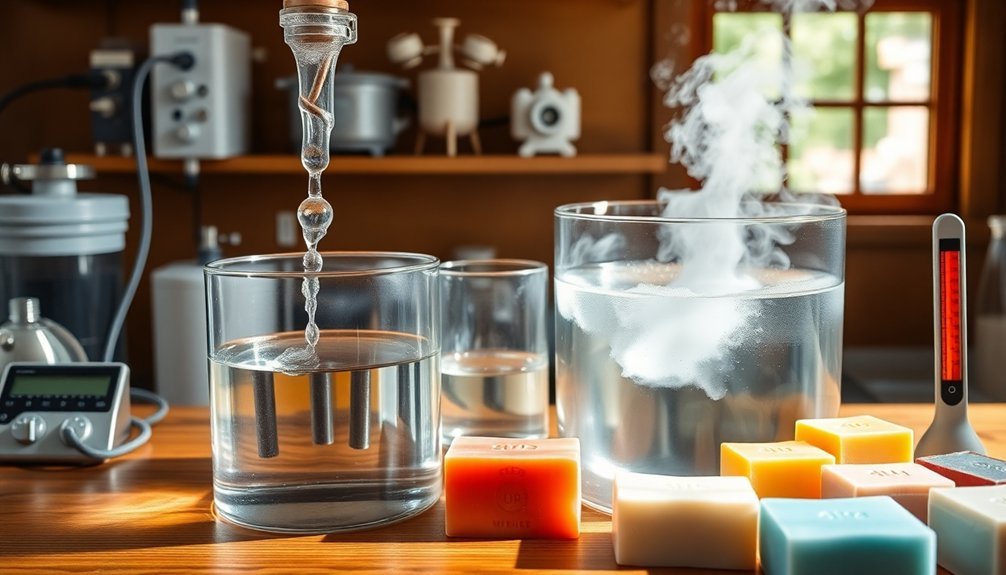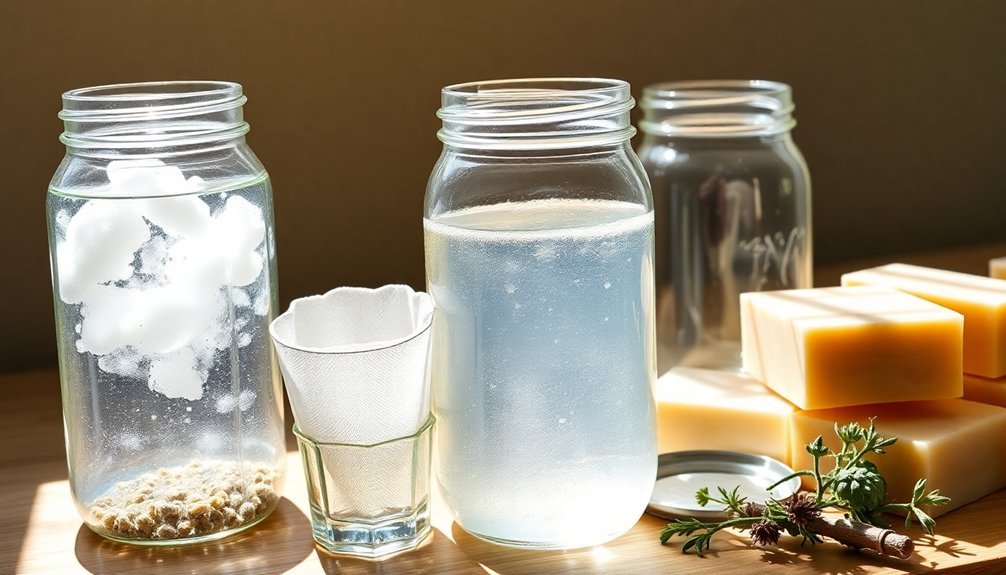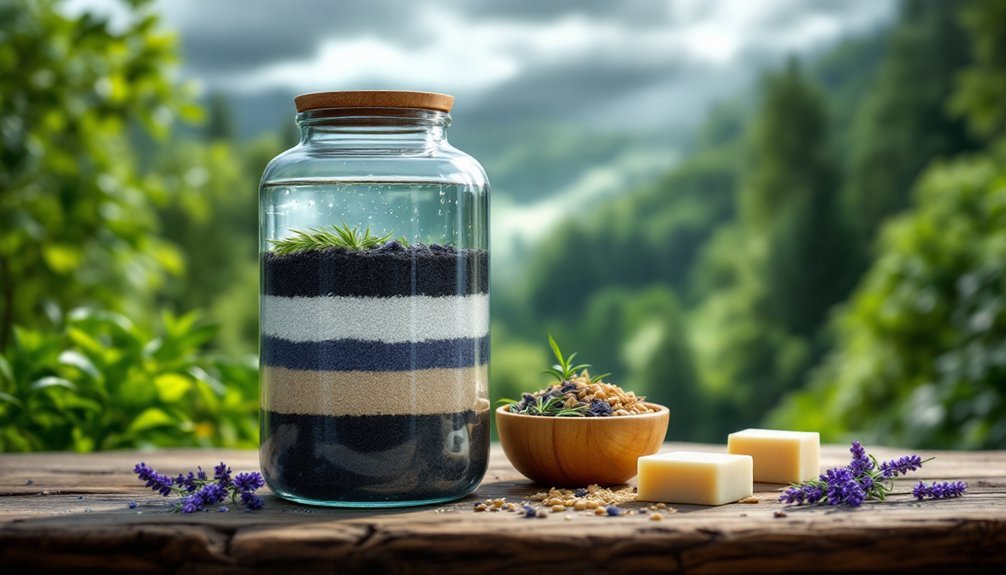For soap making, purify rainwater effectively using one of these five methods: basic filtration with mesh screens to remove debris, activated carbon filtering for chemicals, reverse osmosis for ultra-pure water, UV sterilization to eliminate pathogens, or natural sedimentation followed by boiling. You'll need clean water with minimal minerals for ideal soap consistency and lather. Each purification technique offers specific benefits that can dramatically improve your final product quality.
5 Best Rainwater Purification Methods For Soap Making

Why settle for tap water when nature provides a superior alternative for your soap making endeavors? Rain water offers exceptional purity when properly collected and treated, enhancing your soap's quality.
Collect rainwater during heavy downpours using stainless-steel pots positioned away from runoff areas to minimize contamination.
After gathering, strain out debris and sterilize by boiling for 10-15 minutes to eliminate pathogens that could compromise your soap.
Store purified rainwater in sterile glass jars which won't leach chemicals into your carefully processed water.
Regularly test TDS levels to verify your water meets purity standards necessary for exceptional soap making results.
The water in soap greatly impacts the final product, so taking these steps assures your rainwater provides the cleanest possible foundation for your artisanal soaps.
Filtration Systems: From Basic to Advanced
Now that you understand the importance of proper rainwater collection, let's examine the filtration options that transform your harvested rainwater into soap-making gold.
Basic filtration systems like mesh screens remove larger debris but won't catch microscopic contaminants that affect water quality.
For soap making, consider upgrading to activated carbon filters, which eliminate chlorine and volatile organic compounds while improving taste and odor.
For ultimate purity, reverse osmosis systems use semipermeable membranes to achieve distilled-water-like results with minimal dissolved solids.
Don't overlook UV purification systems, which destroy bacteria and viruses for added safety.
For high quality soap making water, combine multiple methods: start with basic filtration, follow with activated carbon, and finish with UV treatment.
This thorough approach guarantees your rainwater meets the highest standards for soap making.
Boiling and Distillation Techniques

While filtration effectively removes physical contaminants, boiling and distillation techniques address microscopic pathogens critical for soap-making success.
You'll find boiling rainwater for 10-15 minutes eliminates most harmful microorganisms, creating a sterile base for your soap recipes. This process not only sterilizes your water but also helps strain larger debris when properly settled.
For superior purification, consider distillation. This method transforms rainwater into steam before condensing it back to liquid, effectively removing impurities and producing water with extremely low TDS levels (0-5 PPMs). The resulting distilled water is virtually contaminant-free.
Both techniques provide reliable solutions for eliminating bacteria and viruses that could compromise your soap quality.
Whether you choose simple boiling or more thorough distillation, you'll guarantee your rainwater meets the purity standards essential for successful soap making.
UV Sterilization for Pathogen Removal
After filtering out physical contaminants, UV sterilization offers a powerful chemical-free method to eliminate microscopic threats in your rainwater.
This technique uses light at a 254-nanometer wavelength to disrupt pathogen DNA, preventing reproduction and guaranteeing your soap making process begins with properly disinfected water.
For effective UV disinfection:
- Confirm your rainwater is clear and pre-filtered, as turbidity blocks UV light penetration
- Expose water to UV light for 10-30 seconds depending on your system's flow rate
- Maintain your UV lamp regularly to assure consistent purification power
UV sterilization's chemical-free nature makes it environmentally friendly and ideal for natural soap making.
Unlike other purification methods, it won't alter your water's composition or leave residual substances that might affect your final soap product.
Natural Sedimentation and Clarification

Beyond UV sterilization methods, simplicity often yields remarkable results in rainwater purification. Natural sedimentation offers an effortless approach—just allow collected rainwater to rest undisturbed overnight, letting heavier debris settle to the bottom.
After sedimentation, enhance clarification by straining the water through cheesecloth or fine mesh to capture floating impurities. This two-step process greatly improves water clarity, reducing contaminants that might affect your soap making quality.
For peak purity, boil the sedimented water for 10-15 minutes to eliminate remaining pathogens. This extra step guarantees your rainwater is thoroughly sanitized for crafting high-quality soaps.
Store your purified rainwater in sterile glass jars to maintain its purity until you're ready to transform it into luxurious, handcrafted soap.
Frequently Asked Questions
Is Rain Water Good for Soap Making?
Yes, you'll find rainwater excellent for soap making. It's naturally soft and free from minerals that can interfere with lathering. Just be sure to filter and boil it first for safety.
What Are the Methods of Purification of Rainwater?
You can purify rainwater through boiling, using a stainless-steel pot, straining with mesh or cloth, employing activated carbon filters, or utilizing UV light treatment to kill pathogens while preserving water quality.
Can You Use Reverse Osmosis Water for Soap Making?
Yes, you can use reverse osmosis water for soap making. It's an excellent choice as it removes minerals and contaminants that could affect your soap quality, providing consistent results similar to distilled water.
Can I Use Filtered Water for Soap Making?
Yes, you can use filtered water for soap making. It's better than tap water but not as pure as distilled. Confirm your filter removes chlorine and heavy metals for best results. Test TDS levels before using.
In Summary
You've now explored the five best ways to purify rainwater for your soap making adventures. Whether you're filtering, boiling, using UV light, or trying natural sedimentation methods, you'll enjoy better results with clean water. Choose the purification method that fits your production scale and budget. Remember, quality ingredients—including water—are the foundation of exceptional handmade soap.





Leave a Reply